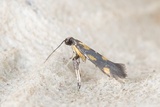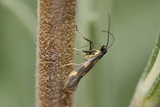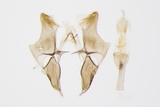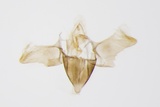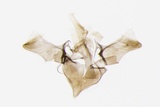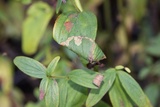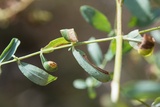Euspilapteryx auroguttella Stephens, 1835 Species
Last modified: Jan. 30, 2025, 6:49 p.m.
A fairly common species in Belgium.
Details
- Classification
- Family: Gracillariidae > Subfamily: Gracillariinae > Tribus: Gracillariini > Genus: Euspilapteryx > Species: Euspilapteryx auroguttella
- Vernacular names
- Hertshooisteltmot (NL), Gold-dot slender (EN), Hartheu-Stelzenmotte (DE)
- Synonyms
- Euspilapteryx lacertella (Zeller, 1839)
- First mention in Belgium
- De Fré Ch. 1858. Catalogue des Microlépidoptères de la Belgique. — Annales de la Société entomologique belge 2: 45–162. On page 146 (as lacertella). view page
- Status
-
Native
Distribution
Mine
The first instars make a narrow, but long, tortuous gallery in the lower epidermis, containing light brownish frass. Later on, this mine is widened into a white blotch.
See also gracillariidae.net and bladmineerders.be.
Cocoon/pupa
Whitish cocoon inside the final roll of cone.
Bionomics
Tissue feeding instars line the inside of the mine with silk. The mine becomes visible from the upper side as white patches. Later on, the mine turns brownish and the leaf is folded over the mine. The frass is concentrated in a corner of the mine. The last instars leave the mine and live freely under a downwards-folded leaf tip. The last instar constructs a final fold, which sometimes causes the leaf to roll op longitudinally or otherwise resembles a little cone made by several Caloptilia species. Pupation takes place in this roll or cone, which in most cases drops to the ground. The pupal skin protrudes from the cocoon after emergence of the moth.
Flight periods
There are 2 generations per year, the adults fly in April–May and again in July–August.
Observed on
- Host plant (species):
- Hypericum perforatum, Hypericum pulchrum, Hypericum hirsutum and Hypericum tetrapterum
The larva feeds on several species of Hypericum, mainly H. perforatum, but also on H. pulchrum, H. hirsutum or H. tetrapterum.
